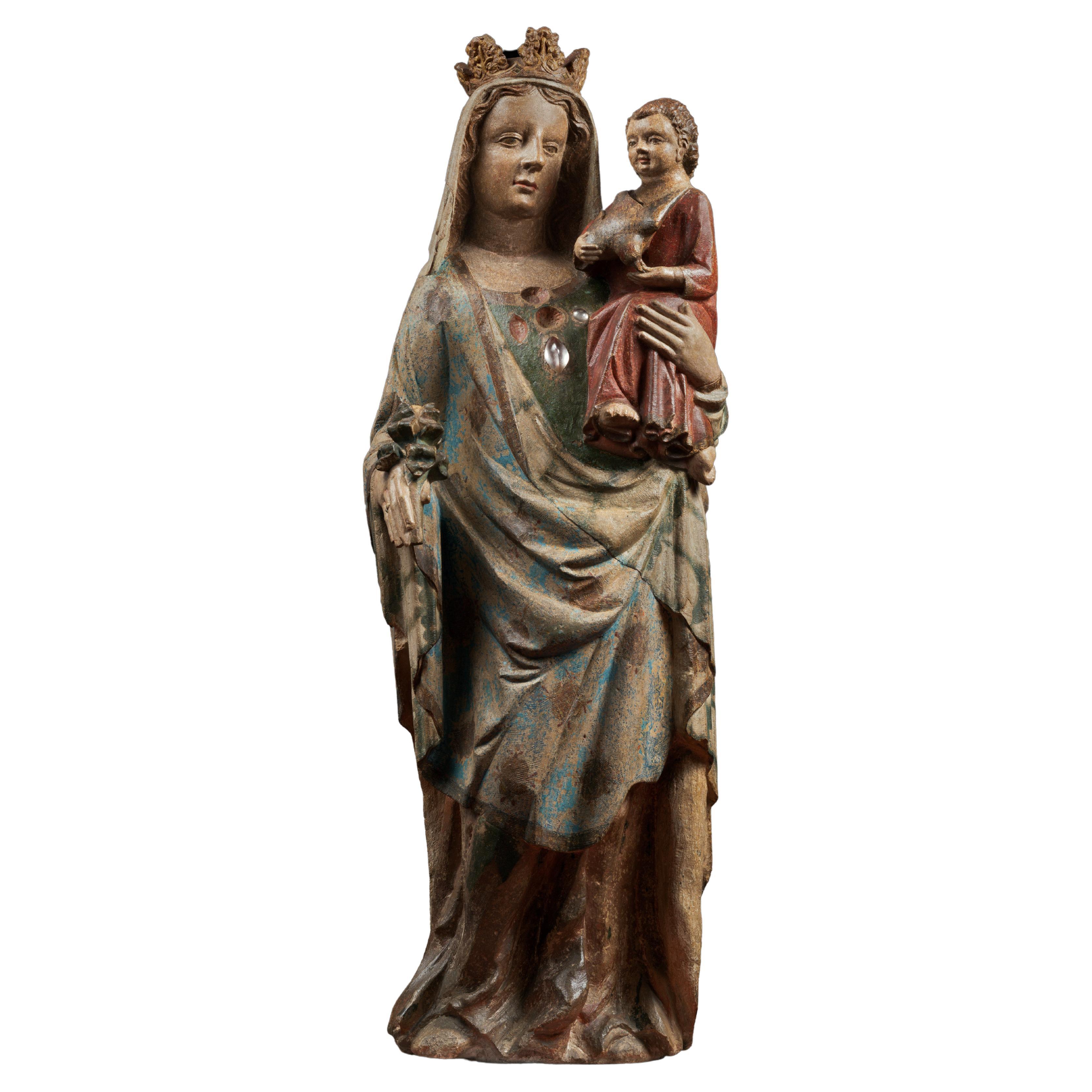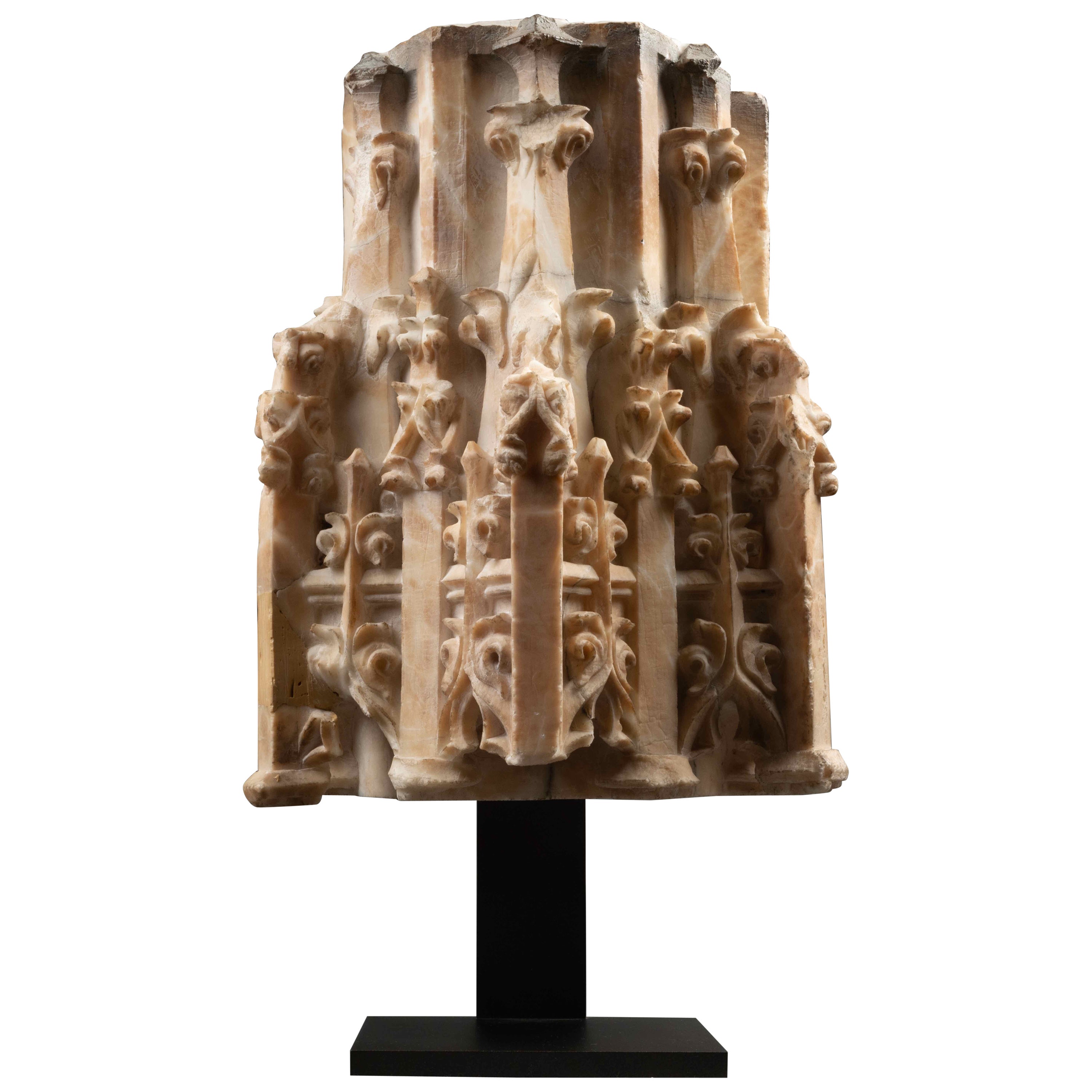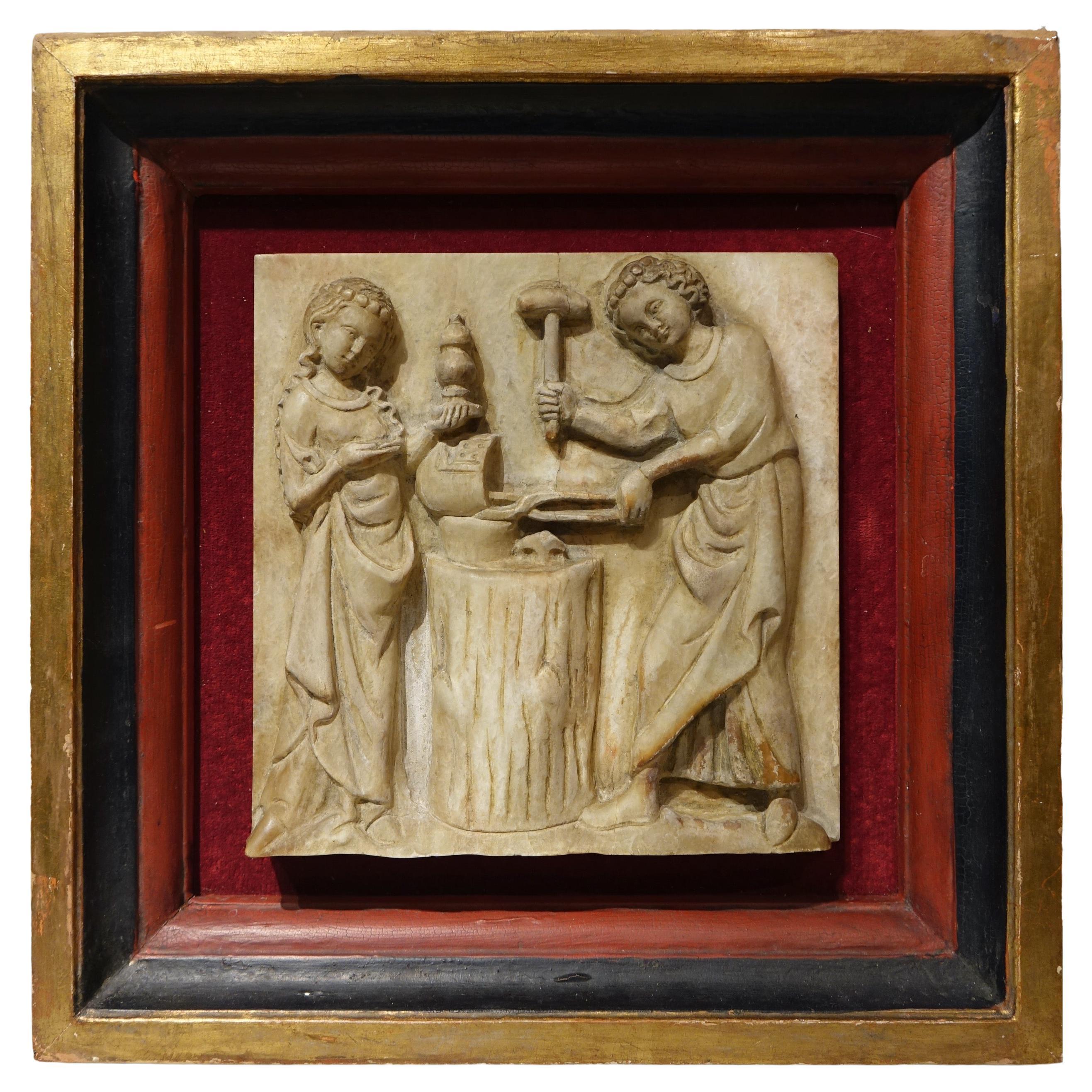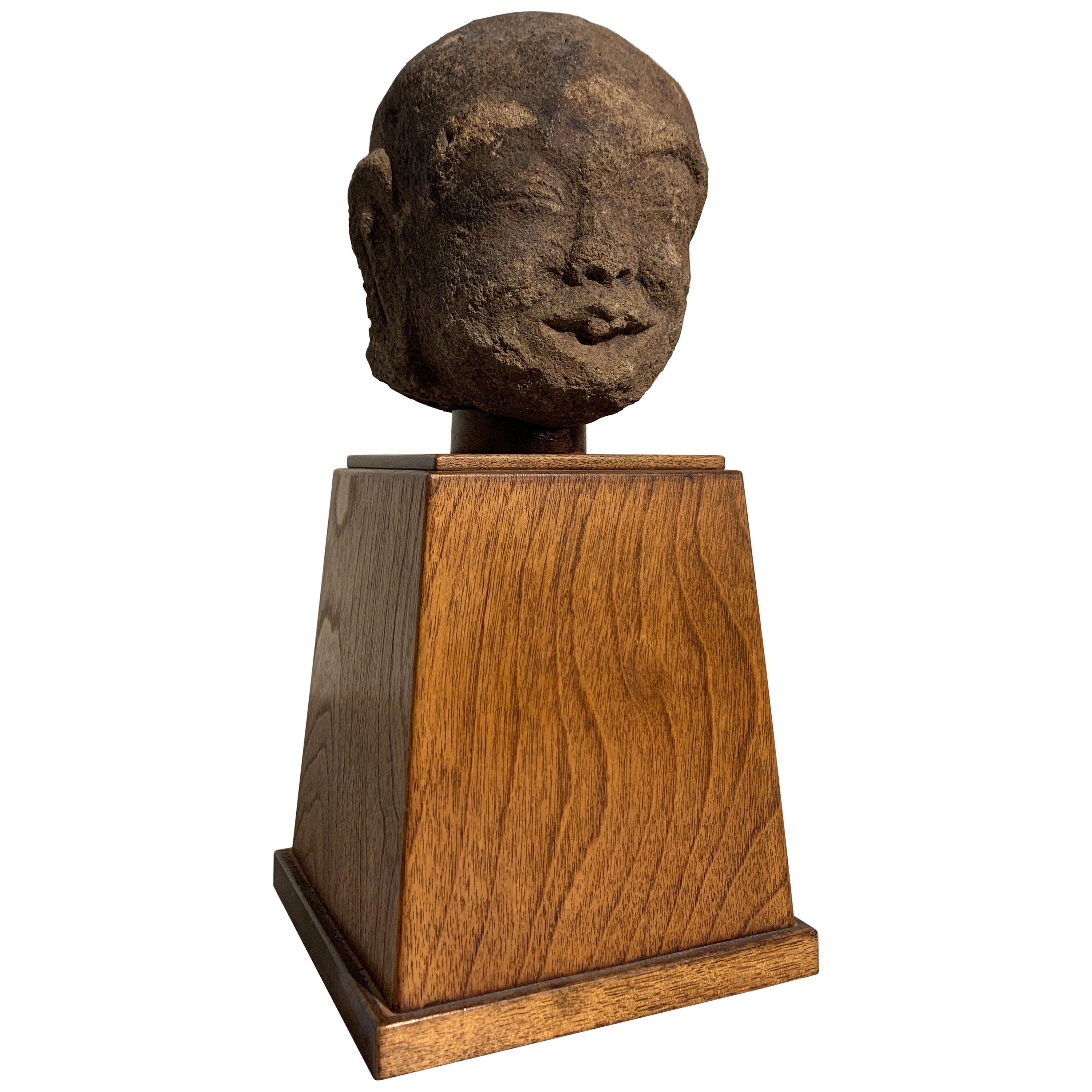Items Similar to Gothic crowned Head - Île de France, 14th century
Want more images or videos?
Request additional images or videos from the seller
1 of 7
Gothic crowned Head - Île de France, 14th century
About the Item
Head of a crowned Virgin
Île-de-France, first half of 14th century.
H26 x 14 x 14 cm
Provenance :
- Private Collection, Paris France (1960)
- Private Collection Tuscany, Italy (1980)
Beautiful face with a slightly triangular shape and delicate features, almond-shaped eyes with tapered ends and finely outlined upper eyelids, high arched eyebrows; long straight nose, mouth with thin lips forming a slight smile; small round chin. Crowned with a fleur-de-lis adorned crown set with lozenge and rectangular cabochons placed on a short veil partially covering the golden and wavy hair, this Virgin impresses with her frontal stance and sophisticated stylization.
The quality of execution, finely drawn features, denote in the sculptor an uncommon sureness of hand, typical of Parisian workshops of the first half of the 14th century. This sculpture can be compared to a Virgin head made in Île-de-France during the first half of the 14th century, preserved at the Louvre and originating from the church of Saint Pierre aux Boeufs in Paris.
The work presents evident affinities with our sculpture: the slightly triangular-shaped head, adorned with a crown of cabochons ending in alternating fleurons; a short veil with flattened folds frames wavy hair; both are frontal, gazing serenely at the faithful. The almond-shaped eyes and delicate smile that marks the face with refined gentleness are stylistic features common to Virgins sculpted in Île-de-France around 1325-1350.
This head is remarkable for the preservation of its original polychromy, with its rich pink and golden hair, as well as for the quality of execution and the softness of the features.
- Dimensions:Height: 10.24 in (26 cm)Width: 5.52 in (14 cm)Depth: 5.52 in (14 cm)
- Style:Gothic (Of the Period)
- Materials and Techniques:
- Place of Origin:
- Period:
- Date of Manufacture:14th century
- Condition:Wear consistent with age and use.
- Seller Location:Bruxelles, BE
- Reference Number:1stDibs: LU6666239227642
About the Seller
5.0
Vetted Seller
These experienced sellers undergo a comprehensive evaluation by our team of in-house experts.
1stDibs seller since 2022
6 sales on 1stDibs
Typical response time: <1 hour
- ShippingRetrieving quote...Ships From: Bruxelles, Belgium
- Return PolicyA return for this item may be initiated within 3 days of delivery.
More From This SellerView All
- Gothic Canopy, France, 15th CenturyLocated in Bruxelles, BEGothic canopy France, 15th century Alabaster, some traces of polychromy 33 x 23 x 20 cm Provenance: - Private collection Genève, Switzerland ...Category
Antique 15th Century and Earlier French Gothic Figurative Sculptures
MaterialsAlabaster
- Gothic Stone Fragment Representing Vine Leaves, France, 15th CenturyLocated in Bruxelles, BEGothic architectural fragment representing vine leaves France, 15th century Sandstone H 21 x 21 x 17 cm mounted on a modern metal pe...Category
Antique 15th Century and Earlier French Gothic Architectural Elements
MaterialsLimestone
- Large Medieval carved frieze - France, 14th-15th centuryLocated in Bruxelles, BEGothic Limestone frieze decorated with curly foliage North of France, 14th-15th century 59,8 x 15,6x 22 cm This French Gothic limestone frieze, adorned with curling foliage, stands ...Category
Antique 15th Century and Earlier French Medieval Architectural Elements
MaterialsLimestone
- Double Romanesque Capital, France, 13th CenturyLocated in Bruxelles, BEDouble romanesque capital decorated with two fantastic animals France, 13th century Measures: 26,5 x 38,5 x 14,5 cm. This rare double cap...Category
Antique 15th Century and Earlier French Medieval Architectural Elements
MaterialsStone
- Romanesque capital with sirens - France 13th centuryLocated in Bruxelles, BERare romanesque capital with sirens France, XIII century Limestone 25 x 28 x 22 cm This finely carved Romanesque capital, executed in high relief from limestone, features four hyb...Category
Antique 15th Century and Earlier French Medieval Figurative Sculptures
MaterialsStone
- Large Hexagonale Base of Pilaster in Burgundy Stone, Burgundy, 15th CenturyLocated in Bruxelles, BELarge base of molded hexagonal pilaster in burgundy stone carved with vines, grapes and rosettes in high relief. Burgundy, 15th century 28 x 63 x 30 cm Provenance : collection De...Category
Antique 15th Century and Earlier French Gothic Architectural Elements
MaterialsStone
You May Also Like
- 14th Century Sculpture of the Head of an Angel from East of France or RhinelandLocated in Saint-Ouen, FRThis face with prominent eyes, open mouth and beautiful hairs with symetrical undulations may be the face of the Archangel Gabriel.Category
Antique 15th Century and Earlier French Gothic Figurative Sculptures
MaterialsWood
- Important 14th Century Polychrome Limestone Virgin from LorraineLocated in Saint-Ouen, FRProvenance : - Kunsthaus Heinrich Hahn, Frankfurt am Main, sale 16, June 17, 1930, lot 16. - Sotheby's, Amsterdam, Feb. 26, 2006, lot 201. HISTORIC Located between Moselle valley and Meuse valley, framed by the Vosges Mountains on the south side and the duchy of Luxembourg on the north side, the duchy of Lorraine is the result of several partitions. It starts with the 9th century when the Carolingian empire is divided, with Lothar 1st inheriting Lotharingia. In 959 this territory was in turn divided in two; Lower and Upper Lotharingia, the latter being the forebear of the duchy of Lorraine. This duchy was under the rule of the Holy Roman Germanic Empire until 1736 when it was absorbed by the kingdom of France. All along its history the duchy of Lorraine has found itself in the midst of many conflicts. Alliances and feuds marking European history were always particularly sensible in Lorraine where instability was frequent. Because of its geographic position the duchy of Lorraine was also an artistic crossroad. Hence the duchy of Lorraine becomes from the 13th century onwards an important artistic centre where a particular type of Virgin and Child appears. According to professor J. A. Schmoll the characteristics of Lorraine sculpture burgeon around 1280-1300 in the Aube region. It presents “vigorous volumes, restrained movements, rare but solemn gestures and a strong interiorised and stern expression”. Those Virgins look similar with a wide forehead, a shield- or oval-shaped face, large neck, small lips and a cleft chin. This model is particularly in favour during the 13th century because of the revival for Marial worship and for the theme of the Virgin and Child. It bears witness to a new religious sensibility with a more intimate vision of religious practice. DESCRIPTION The important 14th century Virgin we present to you is one of the most beautiful examples of sculptural art from Eastern France, with her fascinating distant gaze. Her contrapposto posture is induced by the weight of the child she carries high on her left side. The child has a chubby face framed by blond hair with well defined curls and he wears a long red V-collared tunic from which emerge his feet. The fabric is animated by long folds. The position of the right foot turned to the back is a detail we can notice on several Virgins from Lorraine. He holds a bird that seems to be pecking his thumb. “The bird /held by the child in his hands/ has been read as a reference to an episode from Christ’s childhood when he has moulded sparrows with clay before giving them life. It appears in the apocryphal gospel of Pseudo-Matthew (ch. 27) and later in the Quran (III, 43, v. 110). However the iconography seems to be more influenced by the concept of Redemption or of Eucharist, the bird symbolising the soul of the Christian about to be redeemed or revitalised.” Mary wears a long dress with two rock crystal cabochons remaining from the original five. She is covered by a red cloak enriched with old-gold motifs draped as an apron falling in long pleats along her left hip. The relief treatment and the volume of the cloak developing a network of concentric pleats contrast with the the flat pleating of her dress. They nevertheless suggest the curve of her bent right leg. She wears a floret crown securing a short thin veil carved in very low relief. From it emerges her blond curled hair characteristic of the 13th century. The large face with almond-shaped eyes, straight nose, small lips and cleft chin casts its gaze afar in a fashion typical of 13th century Virgins. In her right hand she holds a lily flower. In a very refined manner the artist has carved a band on her right ring-finger. In the back, carefully sculpted, spreads the minutely detailed short veil. COMPARATIVE STUDIES This sculpture of great quality presents obvious similarities with Virgins from Lorraine, designated by William Forsythe...Category
Antique 15th Century and Earlier French Gothic Figurative Sculptures
MaterialsLimestone
- Alabaster high relief, Spain 14th centuryLocated in PARIS, FRAlabaster plate in high relief illustrating a forgeron working on a metal object (a helmet?). A young woman is in front of him holding in her left hand an ovoid vase or reliquary tha...Category
Antique 15th Century and Earlier Spanish Medieval Figurative Sculptures
MaterialsAlabaster
- Indonesian Majapahit Terracotta Head of a Male, circa 14th CenturyLocated in Austin, TXA charming head of a young male, Majapahit Empire, region of Trowulan, Eastern Java, Indonesia, 13th-14th century. The head well sculpted as a smiling, youthful male with buck teet...Category
Antique 15th Century and Earlier Javanese Tribal Sculptures and Carvings
MaterialsTerracotta
- Antique Lifesize Crowned Mother Mary and Child Jesus Gothic Revival SculptureLocated in Lisse, NLHand carved wood antique statue of Mother Mary wearing a Gothic crown. This original and all hand carved sculpture of the mother of all mothers is anothe...Category
Early 20th Century European Gothic Figurative Sculptures
MaterialsWood
- Important German Pietà from the, 14th CenturyLocated in Saint-Ouen, FRIMPORTANT GERMAN PIETÀ FROM THE 14th CENTURY ORIGIN: GERMANY, REGION DE COLOGNE PERIOD: BEGINNING IF THE 14th CENTURY, ca. 1330 Height: 98 cm Length: 45 cm Depth: 33 cm Polychromed linden wood Good condition of conservation Provenance : particular Alsatian collection The theme of the Pietà or Vesperbild appears in Germany at the end of the 13th century, reflecting the mysticism of the late Middle Ages. Although the theme does not exist in the Gospels, it was often mentioned in contemporary devotional literature. Indeed, during the first half of the 14th century, mystical thought and devotional practices changed under the impulse of a number of religious, among them Heinrich Suso and St Bridget. In his writings, Suso placed important emphasis on contemplation and meditation in the footsteps of Christ's martyrdom. This will have great impact in the field of art, especially in Germany and later in France. The emphasis will from now on be on grief, death is shown in a straightforward way. The wounds of Christ are gaping and bloody. The suffering of Christ and the seven sorrows of the Virgin Mary are meditated upon. This piece demonstrates the interest of the faithful in these representations where pathos reigns. The virgin is represented seated in a frontal position. The bust is very elongated. She is wearing a red dress with a simple neckline and a blue mantel...Category
Antique 15th Century and Earlier Figurative Sculptures
MaterialsWood
Recently Viewed
View AllMore Ways To Browse
Antique Crowns
French Crown
Crown Collection
Crown Italy
Italian Crown Crown
Italian Crown
With Crown Carved
Gothic Original
15th Century Italian Furniture
Golden Crown
Antique Gothic Frame
Gothic Church Furniture
Italian Gothic Furniture
Italian Gothic
French Lozenge
Golden Arches
Antique Italian Gothic
Almond Shape





